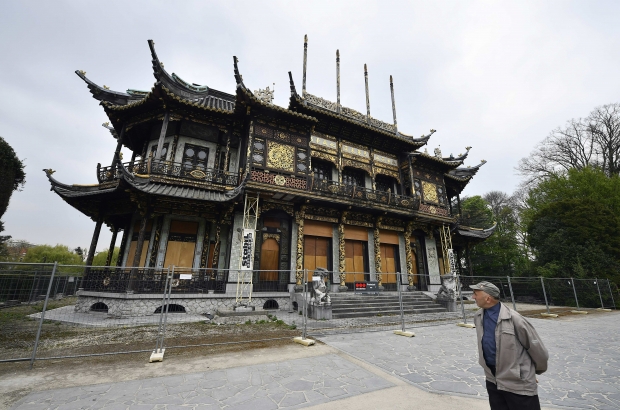- Daily & Weekly newsletters
- Buy & download The Bulletin
- Comment on our articles
New owner and name for Chinese Pavilion in Laeken
The Chinese Pavilion in Brussels' Laeken district will be called the "Palace of the Far East" by 2028 as part of a bigger renovation and redesign of the area.
After a full restoration, the Palace of the Far East will house, among other things, an exhibition area and a diplomatic meeting space, according to state secretary Mathieu Michel, responsible for the federal buildings agency, the Régie des Bâtiments.
“The future Far East Palace must become a calling card of Belgium for Asian countries,” Michel said, describing it as “a new bridge between two cultures”.
The pavilion, which opened in 1913 and has been closed since 2013 due to structural problems, will eventually serve as a place to bring together Belgian and foreign people involved in Far Eastern cultures, both artistically and entrepreneurially.
The exhibition space provided will focus on the history of the Silk Roads and the economic exchanges between east and west. It will also serve as a setting for Belgian-Chinese and Asian diplomatic relations.
The renovation comes after criticism from within the Brussels government over the alleged laxity with which the federal government was treating the site.
Heritage state secretary Ans Persoons was especially angry about the decay of the Chinese Pavilion and the Japanese Tower a hundred metres away, and went to court over the matter.
Persoons is now “happy that there is finally movement on the issue”, saying: "That was also our goal, which was to break the years of stagnation and thus avoid irrevocable damage."
Still, Persoons remains sceptical about the financial viability of the renovation works.
“The plan relies heavily on private investors,” Persoons said. “So there are still many question marks for us about the tight schedule, the non-profit organisation and the lack of a public tender, among other things.”
But Michel says Persoons’ criticism was nothing more than electioneering.
Regarding the Japanese Tower, Michel said that “work is already underway on the stability of the structure” and that he believes that a new use should also be given to that monument in the coming months and years.
The ASBL (non-profit association) set up to renovate and run the site will be headed by Diane Hennebert, who has already successfully renovated the Atomium and the Villa Empain.
“It's not too late to renovate the pavilion, but it's about time,” Hennebert said.
“In the 21st century, we know that so many things are changing and determining our future from the Far East. Why should we deprive ourselves of such a tool when we have it at hand?”
The nearby Japanese Tower, which is also in a poor state of repair, is not officially included in the project.
When asked if it might be, Michel said: “Anything is possible. All you have to do is dream and, above all, make it happen.”
Hennebert called the tower a “next step” to be considered after the Palace of the Far East is launched.
Both structures have significant cultural value in Brussels and in Belgium.
Asia became a trending source of inspiration for artists at the dawn of the 20th century. Leopold II went to the Universal Exhibition in Paris in 1900 and on several occasions visited the ‘Round the World’ panorama. Charmed, he commissioned a similar site from the Parisian architect Alexandre Marcel, who designed the Japanese Tower at that exhibition and a Chinese Pavilion.
The project was approved in 1901 and work on the Chinese Pavilion and its ancillary buildings, including the kiosk and the Koetsehuis, began in 1903. Leopold II never saw the completed Pavilion, as he died in 1909 before it was inaugurated in 1910.
The Japanese Tower was dismantled after the close of the Paris Exhibition and reassembled near the Chinese Pavilion to form a cohesive site.
Initially, the king intended to turn the Chinese Pavilion into a luxury restaurant specially dedicated to people and companies developing trade relations with China and the Far East. But in the end, the foreign affairs ministry used it as a permanent exhibition of products imported from the Far East.
The site saw several renovations, repurposing, reopenings and closures over the next century before eventually falling into its current state of disrepair.
To bring about the Pavilion’s next renovation, repurposing and operation, Belgium’s federal government turned to private partners with a total budget estimated at up to €5 million. The Régie des Bâtiments is in charge of the renovation, while the private partners will guarantee the budget.
The Buildings Agency and the foreign affairs ministry are the founding members of the non-profit association that will be responsible for the operation and maintenance of the pavilion, which must be fully restored by 2028 at the latest.
It is hoped that it will open to the public in 2027, the year that will mark 80 years of diplomatic relations between China and Belgium.


















